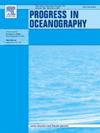The role of the Atlantic-Ionian stream in the long-term variability of the surface circulation in the Northern Ionian Sea: Results from a hindcast simulation
IF 3.6
3区 地球科学
Q1 OCEANOGRAPHY
引用次数: 0
Abstract
We examine the long-term variability of the near-surface circulation of the Ionian Sea. Our analysis primarily focuses on a high-resolution hindcast simulation of the Mediterranean dynamics from 1981 to 2010. This time period is significant as it includes a notable near-surface circulation reversal in the Northern Ionian Sea (NIS), which shifted from anticyclonic to cyclonic at the end of 1997. This transition has been previously documented by altimeter data and Copernicus reanalysis. Our hindcast simulation accurately captures this change. Here we examine the temporal and spatial scales of the near-surface circulation during the transition and investigate the factors contributing to the observed variability of the basin dynamics, including local wind-stress, deep-water density anomalies, and the lateral current associated with the Atlantic Ionian Stream (AIS). We find that while wind stress does play a role, the primary factor driving long-term variability in the NIS near-surface circulation is the AIS. During the late 1980s to mid-1990s, the AIS was weak and local cyclonic winds were also weak, allowing the AIS to enter the NIS along the coasts of Sicily. This led to the formation of a wide anticyclonic cell in the NIS. From the mid-1990s to 2010, the AIS was stronger and, favored by stronger cyclonic winds, detached from the coasts of Sicily heading directly towards the Levantine basin without penetrating the NIS. This process led to the formation of a wide cyclonic cell over the NIS. These results highlight the role of the AIS in controlling the circulation of the NIS.
大西洋-爱奥尼亚流在北爱奥尼亚海地表环流长期变率中的作用:后播模拟的结果
我们研究了爱奥尼亚海近海面环流的长期变化。我们的分析主要侧重于 1981 年至 2010 年地中海动态的高分辨率后报模拟。这一时期具有重要意义,因为其中包括北爱奥尼亚海(NIS)近表层环流的显著逆转,即 1997 年底从反气旋环流转变为气旋环流。以前的测高仪数据和哥白尼再分析都记录了这一转变。我们的后报模拟准确地捕捉到了这一变化。在这里,我们研究了过渡期间近表层环流的时空尺度,并调查了导致观测到的海盆动力学变化的因素,包括当地风压、深水密度异常以及与大西洋爱奥尼亚流(AIS)相关的侧向洋流。我们发现,虽然风压确实起了一定作用,但驱动近海环流长期变化的主要因素是大西洋爱奥尼亚海流。在 20 世纪 80 年代末到 90 年代中期,爱奥尼亚海流很弱,当地的气旋风也很弱,使得爱奥尼亚海流能够沿西西里岛海岸进入近海环流。这导致在新近独立国家形成了一个广泛的反气旋单元。从 20 世纪 90 年代中期到 2010 年,AIS 变得更加强大,在更强的气旋风作用下,AIS 脱离西西里岛海岸,直接向黎凡特盆地移动,而没有穿透新近独立国家。这一过程导致在新近独立国家上空形成了一个大气旋。这些结果突显了 AIS 在控制新近独立国家环流中的作用。
本文章由计算机程序翻译,如有差异,请以英文原文为准。
求助全文
约1分钟内获得全文
求助全文
来源期刊

Progress in Oceanography
地学-海洋学
CiteScore
7.20
自引率
4.90%
发文量
138
审稿时长
3 months
期刊介绍:
Progress in Oceanography publishes the longer, more comprehensive papers that most oceanographers feel are necessary, on occasion, to do justice to their work. Contributions are generally either a review of an aspect of oceanography or a treatise on an expanding oceanographic subject. The articles cover the entire spectrum of disciplines within the science of oceanography. Occasionally volumes are devoted to collections of papers and conference proceedings of exceptional interest. Essential reading for all oceanographers.
 求助内容:
求助内容: 应助结果提醒方式:
应助结果提醒方式:


